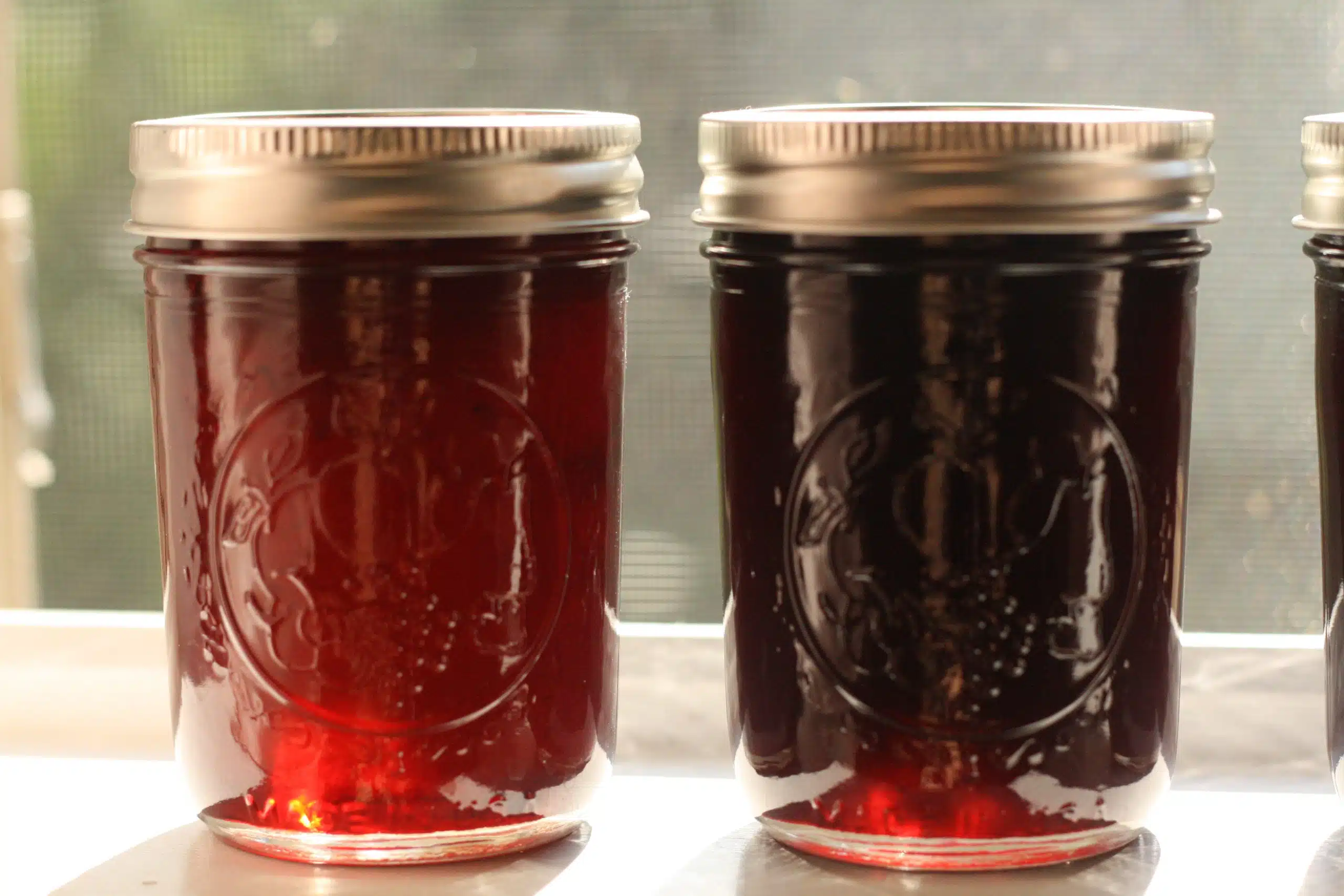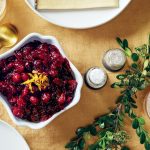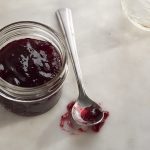Beach Plum Jam
We let the natural pectin in the fruit do the work in this beach plum jam recipe. You’ll get a slightly looser jam but brighter plum flavor.

How to Make Beach Plum Jam
Photo Credit: Amy TraversoMany people use pectin to set their jams and jellies, and that’s a fine method, but we prefer to let the natural pectin in the fruit do the work when we make this beach plum jam. You’ll get a slightly looser jam but brighter plum flavor. Red wine adds depth and color.
LEARN MORE:
How to Make Beach Plum Jam
Crab Apple Jelly Recipe
Yield:
4 cups
Ingredients
4 cups whole beach plums
4 cups granulated sugar
1 cup medium-bodied red wine, such as Merlot
Instructions
Put a porcelain or ceramic plate in the freezer to chill. Meanwhile, combine all ingredients in a 5- to 6-quart heavy-bottomed pot over medium-high heat.
Bring to a simmer so that the plums release their juices. Let cook 5 more minutes. Then pour mixture into a strainer set over a bowl, and press on the solids to extract the juice and fruit.
Return extract to heat and simmer, stirring often, 25 minutes. Reduce heat as needed to keep from boiling up. Remove the chilled plate from the freezer and spoon a small amount of jam onto it. It should thicken when it hits the cold. If it’s thick enough, stop there. If not, return the plate to the freezer and continue cooking the puree, checking it at 5-minute intervals, until it reaches the desired thickness (it should form a skin when chilled).
Pour into hot, sterilized jars to within 1/4 inch of the top, adjust lids, and process in boiling water 5 minutes. Let cool at room temperature and check seals.





Can you please tell me what a “Beach Plum” is? I have never heard of them before. Also, do they grow in California and New Hampshire?
Thank you in advance for the reply.
The Beach plum has showy flowers that attract native pollinators. It also has edible fruit, making it valuable for people and wildlife.
The berry itself when ripe resembles the same color as a blueberry with a more purple tone , the tree itself a whitish color , leaves starlike pattern , always grow in close proximity to beach here on longisland I find them on the north shore but I have seen them on fire island and montauk , great for pies and jams smoothies but are sometimes challenging to find existing trees and all costal areas are so populated , the berry of yesteryear !
I have always bought beach plum Jelly when I stop in Lewes, DE to see a family friend. I love it! Living on Long Island, I knew they were around, but didn’t know where. I went on a foraging hike on the North Shore and was shown exactly where they are. I was so excited to pick the fruit! Unfortunately, the deer know where the trees are and beat me to the best harvest. I managed to pick a quart, which was just enough for this recipe. I’ve used pectin to make jam, but with such a small amount of fruit, I was leery of using a smaller amount, so I went with this recipe. It turned out wonderful! Can’t wait for next year to make it again!
Beach Plum Jam.. a childhood favorite..
Can you recommend a source that ships out-of-state? Thank you..
I, too, would like to order authentic, quality beach plum jam. Where do you suggest?
I have a small jam company, StoneLedge Gardens . I picked up my beach plums from Tiverton RI today. You can find me on Facebook.
Beach plums like salty soil. They will grow vigorously far from the ocean in areas that catch runoff from winter-salted roads.
“Beach Plums” are actually “rose hips” (the part that remains after wild rose bushes flower.) They are prevalent in the beach areas and dunes on the “East End” of Long Island.especially the Hamptons and Montauk.
100% incorrect, Ray. They are two different things! Different size, different color, different taste, different texture, grow on different plants. The only thing that is the same is that they are both at the beach.
Absolutely incorrect Ray! Beach Plums are beach plums and rose hips are rose hips. Totally different fruit. They look different and taste different. Yes they both grow on the beach and are harvested in September. Beach plums are my favorite for making jelly and brandy.
To the most recent poster, I believe you are confusing the ‘rose hips’ of Rosa rugosa (an invasive) with the true Beach Plum or Prunus maritima. We used to pick beach plums at Fire Island before deer ate all the plants. Now i pick beach plums in late September on Cape Cod. As for the recipe, the idea of adding red wine is great. As to the ratio of sugar: beach plums we prefer 3 to 3.5 cups of sugar to 8 cups of beach plums. We also use a Foley Food Mill. But the best tool I bought at Snows Home & Garden (Orleans, MA) is a Prepworks by Progressive cherry pitter. It pits 4 beach plums at one time. Pit them before cooking them–makes making jam much easier.
I was just on Martha’s vineyard and went to West Tisburys farmers MKT.Lynne Daniels was selling beach plum jam with other flavors among them a strawberry peach that was delicious!Her website is:seaweedz8@yahoo.com or phone or text:585-451-3115.I believe she can ship her homemade jams.Got a grape/ horseradish to go with various roasts too.
A friend on Nantucket just brought me a big bucket full of beach plums and I’m gonna try to make jelly with my 12yr old. The berries are more reddish and some purple than the dark purple of a blueberry. I’m hoping they’re ripe enough ???????? We’ll see. I’d never heard of the wine addition. Think we’ll try it ‘cus it sounds delicious 🙂
I really don’t think red wine belongs in Beach Plum Jelly or Jam. Just my opinion. I love the flavor of beach plums. Great snack while walking on the beach.
Hello.
It’s fun to read the various Beach Plum comments.
As for me, I cannot imagine wine in beach plum jelly.
Nope, I agree with several of your other readers. 1) rose hips/Rosa rugosa and 2) beach plums/Prunus maritima are not the same. However, both grow near the ocean & both are edible.
During the fifties our family used to pick beach plums alongside the dirt roads in Harwich Port in late August. Soon thereafter, Mother would turn them into superb jelly.
When preparing the jelly, it’s helpful to include a few of the less ripe fruits (for their pectin content) along with the ripe red & purple plums — if you’re not using a commercial pectin jell.
For guests or gifts we would buy a few jars of Cora’s Beach Plum Jelly from her stand in Wellfleet. Long gone, I feel sure. Great memories, though.
Thanks for your wonderful topical stories.
We picked beach plums on Fire Island in the 40’s and 50’s for jam. They grew wild. I never heard of them referred to or compared with rose hips. I have had commercially prepared jam but it is never the same. Can you recommend where an Arizonan can acquire the real deal?
“Reptiles” on eBay has the best, dark purple beach plum seeds. Posts around Oct 1st each yr.
Here is some information about cultivating beach plums, Prunus maritima, in your garden. Several seed-grown bushes are now bearing fruit trees in a landscape bed I maintain for the Biology department at CCSU here in central Connecticut. After growing them for a couple years in containers, I planted them along the top of a usually quite dry three foot high by twenty foot long and fifteen foot wide mound of sandy loam soil brought in by landscapers many years ago and long ago planted with Montauk Daisies and dwarf junipers. The seeds came from fruit I harvested on Cape Cod about seven years ago. I irrigate the bushes during the summer on occasion (and this summer those occurred at least once a week). The bushes have been bearing collectively about four gallons of plums for each of the past three years. Their yield is most impacted by the weather when they are flowering. Two, which received more water during their early years, are about 7 feet high and equally wide. The other two are barely three feet high and are sparsely branched. They however were particularly loaded with fruit this summer. The largest and most exposed of the bushes flowered when few pollinators were around and set very few fruit. The other large bush did significantly better, but was far from loaded down. The two smaller bushes were freakishly covered with fruit–they looked like they were clusters of grapes and I harvested them by simply combing my hands along the branches, dislodging the plums and letting them fall into a wide tray below.
Insect and Disease Issues: So far, while three young Pluots growing fifty feet away have already had issues with black knot, the beach plums have not. I don’t use fungicides or pesticides on them. Consistently over the three harvests, a very small percentage of the fruit have been visited by insects and are damaged. This damage is fairly easy to spot when you are harvesting, or as you rinse the fruit.
Growing Beach Plums from seeds:
I’ve had good success with this approach. First, I harvest the ripe beach plums, and before I cook them, I simply squeeze out the pits from a dozen or more of them using my finger and thumb. I’ve collected 50 seeds so far this season, and will collect 50 more from yesterday’s harvest. After I have squeezed the seeds out of the plums, I rinse them in cold water, giving them a bit of a collective rub in both hands to remove most of the pulp. I don’t try to get them perfectly clean. Next, I put the pits into a Zip-loc plastic bag along with a handful or two of damp sphagnum peat (peat is very acidic and is a natural fungus inhibitor, so don’t try to use regular soil or even peat-based potting soil, which is treated with lime to raise the pH), seal the baggy, and put it into the crisper of my refrigerator until March. I’ve had quite a few pits sprout on their own in the peat in the fridge by March.
In March, whether they’ve sprouted or not, I remove the seeds from the peat and plant them an inch deep in 7 inch pots, 6 or 8 pits to a pot, using normal potting soil. I water them and after the water has had an hour or three to drain, I put them, covered with plastic domes or in plastic bags to keep them from drying out, into a cool spot in the greenhouse or into a cold frame, but not in a location where they will get much sun. Once they’ve sprouted, I tend to keep them in a shady location for their first year. NOTE: once the seedlings have emerged, they need to be protected from squirrels or chipmunks for at least their first spring: the animals will go after the nutrients that are still left in the seed leaves or cotyledons for some weeks after the seedlings are above ground. I have several seedlings from this spring on my back deck still wrapped in a cocoon of 1/2 hardware mesh after one critter or the other dined on several of their siblings. The seedlings don’t grow very much above ground their first year or two, so they should probably be kept in containers for two years or grown in protected beds and transplanted to their permanent locations in their third spring. By then, they should have good root systems. Once established, they can easily put out two feet of new growth a year. If not pruned, my best guess is that they will fairly easily reach about 8 to 10 feet in height when the conditions are ideal.
A note about beach plum flowers: On my bushes, the flowers buds show up in tiny clusters of four blossoms each, and most of the previous year’s new growth produces many clusters of flower buds along a good part of each shoot. In full bloom the bushes are quite impressive.
Don- great posts. Many thanks. I pit beach plums I pick before making jam. Wish I read your posts before I threw hundreds of beach plum stones (pits? seeds?) into my compost. Will follow your directions next year. When you plant your beach plums in the ground do you have very sandy soil where you live? If not, do you add lots of sand to the area you plant your beach plums in? My mother-in-law lives in Central CT and know her soil is more like clay, not sandy. Very different environment than Cape Cod. Do you fertilize your beach plum plants at all? I would not expect to, but do use organic fertilizer on our lawn; expect some might run off to beach plums planted there.
When I was a child my Auntie Barbara would make not only beach plum jelly but beach plum cordial, which was served at Thanksgiving. This is the first time I will attempt to make both. I picked them on my Truro property. This is a banner year for beach plums(2021) they were in large clusters and covered the bush. One thing not mentioned is often times poison ivy is near the bushes so beware! The recipe sounds delicious but I may just stick with the basics. Happy picking !
It certainly was a banner year for beach plums on Cape Cod! I live in Brewster and did great here then went to Truro to pick up some canning jars and could not believe the beach plums out your way! Picked a total of 15 gallons! Made a lot of liquor and froze the rest to make jam. Now, I just need to find lids!!!!
Some folks have asked about where to acquire beach plum jam, seeds, and plants. Depending on the time of year, I have each of those available in the Etsy shop for my small family farm: https://www.etsy.com/shop/LionandBearNanofarm